Altair 8800
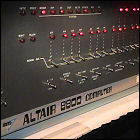 The January 1975 issue of Popular Electronics Magazine goes on sale days before Christmas 1974, with its cover article heralding the arrival of the MITS Altair 8800 microcomputer. The first open-architecture microcomputer, the Altair is available in kit form or fully assembled, with 4K of RAM built around an Intel 8080 processor. Expecting to sell a few hundred kits, MITS founder Ed Roberts finds himself flooded with so many orders that he has to hire additional workers to start catching up with the backlog of purchases, with the time from order to delivery stretching into months. This is the beginning of the modern computer revolution, with companies other than MITS producing peripherals and software for the Altair. The most notable of these third-party vendors is a newly-formed company called Microsoft – a two-man operation founded by Bill Gates and Paul Allen – which produces a working version of the BASIC language for the Altair.
The January 1975 issue of Popular Electronics Magazine goes on sale days before Christmas 1974, with its cover article heralding the arrival of the MITS Altair 8800 microcomputer. The first open-architecture microcomputer, the Altair is available in kit form or fully assembled, with 4K of RAM built around an Intel 8080 processor. Expecting to sell a few hundred kits, MITS founder Ed Roberts finds himself flooded with so many orders that he has to hire additional workers to start catching up with the backlog of purchases, with the time from order to delivery stretching into months. This is the beginning of the modern computer revolution, with companies other than MITS producing peripherals and software for the Altair. The most notable of these third-party vendors is a newly-formed company called Microsoft – a two-man operation founded by Bill Gates and Paul Allen – which produces a working version of the BASIC language for the Altair.
Community Memory
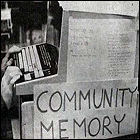 Early networked computing pioneers Lee Felsenstein, Efrem Lipkin and Mark Szpakowski open the first public Community Memory terminal at Leopold’s Records in Berkeley, California. With read-only access for free (and a 25-cent charge to add information to the database, which is maintained on a SDS 940 mainframe at TransAmerica Corporation and accessed via 110 baud acoustic modem), the intention is to computerize the popular push-pin-powered public notice board. Other terminals are eventually made available at various locations, but the SDS 940 proves to be inadequate, and this first iteration of the Community Memory Project will eventually be deactivated in January 1975. Some computer historians regard this as the first computer bulletin board system, although it was accessible only by being physically present at one of the provided nodes. The first dial-up BBS will not appear until 1978.
Early networked computing pioneers Lee Felsenstein, Efrem Lipkin and Mark Szpakowski open the first public Community Memory terminal at Leopold’s Records in Berkeley, California. With read-only access for free (and a 25-cent charge to add information to the database, which is maintained on a SDS 940 mainframe at TransAmerica Corporation and accessed via 110 baud acoustic modem), the intention is to computerize the popular push-pin-powered public notice board. Other terminals are eventually made available at various locations, but the SDS 940 proves to be inadequate, and this first iteration of the Community Memory Project will eventually be deactivated in January 1975. Some computer historians regard this as the first computer bulletin board system, although it was accessible only by being physically present at one of the provided nodes. The first dial-up BBS will not appear until 1978.
IBM 3340: the Winchester hard drive
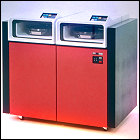 IBM introduces the Model 3340 hard disk drive system for its System/370 mainframe computers. Housed in a large casing similar to a combined washer and dryer, this is the birth of modern hard disk technology, with read and write heads integral to the drive itself rather than being mounted on an arm which reaches into the drive casing. The 3340’s removable modules, each containing drive platters and the read/write heads, can be swapped out with other modules containing other drives. IBM ships the 3340 with two maximum storage capacities: 35 megabytes or 70 megabytes; the unit is internally called a Winchester hard drive, a case of a code name that sticks well beyond development. The 3340 is available through 1984.
IBM introduces the Model 3340 hard disk drive system for its System/370 mainframe computers. Housed in a large casing similar to a combined washer and dryer, this is the birth of modern hard disk technology, with read and write heads integral to the drive itself rather than being mounted on an arm which reaches into the drive casing. The 3340’s removable modules, each containing drive platters and the read/write heads, can be swapped out with other modules containing other drives. IBM ships the 3340 with two maximum storage capacities: 35 megabytes or 70 megabytes; the unit is internally called a Winchester hard drive, a case of a code name that sticks well beyond development. The 3340 is available through 1984.
You’ve got mail
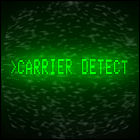 Computer engineer and recent MIT graduate Ray Tomlinson, working on the nascent ARPAnet project, adds minor new features to an experimental file transfer protocol and, in so doing, sends the first network e-mail. This first message doesn’t have far to travel – it arrives at another computer terminal in the same room – but it is the beginning of e-mail on ARPANET, a feature which is adopted so widely and so quickly that it accounts for 75% of all ARPANET data traffic just two years later. Tomlinson is also credited for inventing the user@destination e-mail address format.
Computer engineer and recent MIT graduate Ray Tomlinson, working on the nascent ARPAnet project, adds minor new features to an experimental file transfer protocol and, in so doing, sends the first network e-mail. This first message doesn’t have far to travel – it arrives at another computer terminal in the same room – but it is the beginning of e-mail on ARPANET, a feature which is adopted so widely and so quickly that it accounts for 75% of all ARPANET data traffic just two years later. Tomlinson is also credited for inventing the user@destination e-mail address format.
Happy birthday, Internet!
 This is the observed day of the internet’s birth, actually marking the day that the Defense Advanced Research Projects Agency chose the contractor to build the initial nodes and connections of the ARPAnet. Though the internet is ubiquitous from a 21st century perspective, its origins lie in a disquieting Cold-War-era concept of a distributed computer communications network whose operations could continue even if multiple nodes of the network have been disrupted or destroyed. ARPAnet, the forerunner to the modern internet, will become operational on an experimental basis later in 1969.
This is the observed day of the internet’s birth, actually marking the day that the Defense Advanced Research Projects Agency chose the contractor to build the initial nodes and connections of the ARPAnet. Though the internet is ubiquitous from a 21st century perspective, its origins lie in a disquieting Cold-War-era concept of a distributed computer communications network whose operations could continue even if multiple nodes of the network have been disrupted or destroyed. ARPAnet, the forerunner to the modern internet, will become operational on an experimental basis later in 1969.
The Mother of All Demos
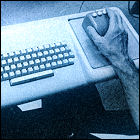 At the Fall Joint Computer Conference held at the San Francisco Convention Center, computer visionary Douglas Englebart demonstrates a collaborative computer system loaded down with groundbreaking technologies: the first computer mouse, driving a point-and-click object-oriented graphical user interface, bitmapped graphics, hypertext, real-time video conferencing, and a live networked collaborative space. Decades later, computer historians give this event – billed in the conference program as “a research center for augmenting human intellect” – a new name: the mother of all demos.
At the Fall Joint Computer Conference held at the San Francisco Convention Center, computer visionary Douglas Englebart demonstrates a collaborative computer system loaded down with groundbreaking technologies: the first computer mouse, driving a point-and-click object-oriented graphical user interface, bitmapped graphics, hypertext, real-time video conferencing, and a live networked collaborative space. Decades later, computer historians give this event – billed in the conference program as “a research center for augmenting human intellect” – a new name: the mother of all demos.
A computer for everyone! In the future!
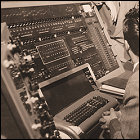 In the Hillsboro Press-Gazette, ENIAC and UNIVAC co-creator Dr. John Mauchly predicts that there will come “a time when everyone will carry his own personal computer”, even going so far as to anticipate portable “hand computers” used for such tasks as interactive shopping lists. Mauchly’s predictions aren’t 100% accurate, however: by the 21st century, groceries do not arrive via delivery chutes in every home, and he fails to anticipate the use of “hand computers” to access social networks or view amusingly captioned photos of cats.
In the Hillsboro Press-Gazette, ENIAC and UNIVAC co-creator Dr. John Mauchly predicts that there will come “a time when everyone will carry his own personal computer”, even going so far as to anticipate portable “hand computers” used for such tasks as interactive shopping lists. Mauchly’s predictions aren’t 100% accurate, however: by the 21st century, groceries do not arrive via delivery chutes in every home, and he fails to anticipate the use of “hand computers” to access social networks or view amusingly captioned photos of cats.
The light-emitting diode
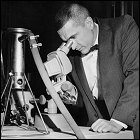 Working at General Electric’s New York R&D lab, scientist Nick Holonyak fires up the first working visible-spectrum light-emitting diode, producing a single small red light. (Texas Instruments had already created infrared LEDs the year before.) Too expensive to mass-produce initially, LEDs will become commonplace in calculators and other electronic devices in the 1970s, though more modern variants in the 1990s will lead to a revolution in lighting and display technology, resulting in flat-screen computer monitors and televisions and spinoff technology such as tablet computers and portable telephones with LED-based touchscreens – all unimaginable in 1962.
Working at General Electric’s New York R&D lab, scientist Nick Holonyak fires up the first working visible-spectrum light-emitting diode, producing a single small red light. (Texas Instruments had already created infrared LEDs the year before.) Too expensive to mass-produce initially, LEDs will become commonplace in calculators and other electronic devices in the 1970s, though more modern variants in the 1990s will lead to a revolution in lighting and display technology, resulting in flat-screen computer monitors and televisions and spinoff technology such as tablet computers and portable telephones with LED-based touchscreens – all unimaginable in 1962.
Spacewar!
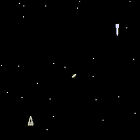 At the 1962 Open House held at the Massachusetts Institute of Technology, a student programming project is unveiled on the school’s new DEC PCP-1 computer. In an attempt to demonstrate the machine’s real-time processing power in a context that can be understood by the general public, Steve Russell and his cohorts allow visitors to play the first computer game, Spacewar. The product of months of design and hundreds of man-hours of coding, Spacewar allows two players to navigate their way around the gravity of a sun while trying to blow each other to bits (as displayed on a round oscilloscope). Never patented or copyrighted, Spacewar goes on to “inspire” countless copies, including one of the earliest coin-operated arcade video games, Computer Space.
At the 1962 Open House held at the Massachusetts Institute of Technology, a student programming project is unveiled on the school’s new DEC PCP-1 computer. In an attempt to demonstrate the machine’s real-time processing power in a context that can be understood by the general public, Steve Russell and his cohorts allow visitors to play the first computer game, Spacewar. The product of months of design and hundreds of man-hours of coding, Spacewar allows two players to navigate their way around the gravity of a sun while trying to blow each other to bits (as displayed on a round oscilloscope). Never patented or copyrighted, Spacewar goes on to “inspire” countless copies, including one of the earliest coin-operated arcade video games, Computer Space.
MIT to design Apollo spacecraft computers
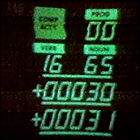 The first government contract is issued in the Apollo lunar landing program, as MIT lands the contract to develop the guidance and navigation computer at the heart of the Apollo vehicles. For its day, MIT designed one of the most robust computers that early ’60s technology could squeeze into such a small space; modern digital watches are far more powerful than that computer. The same computer system will be installed in both the command module and the lunar module.
The first government contract is issued in the Apollo lunar landing program, as MIT lands the contract to develop the guidance and navigation computer at the heart of the Apollo vehicles. For its day, MIT designed one of the most robust computers that early ’60s technology could squeeze into such a small space; modern digital watches are far more powerful than that computer. The same computer system will be installed in both the command module and the lunar module.
The integrated circuit
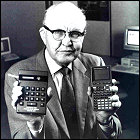 Implementing a revolutionary new take on an idea that has existed on paper since the 1940s, recently-hired Texas Instruments engineer Jack Kilby demonstrates the first fully-functional integrated circuit, with all of the electronic components encased in germanium. While the U.S. Air Force immediately places an order for TI’s new integrated circuits, other engineers continue to refine Kilby’s invention, with Fairchild Semiconductor producing ICs encased in silicon. The move to silicon for ICs leads to smaller electronic devices and the development of microcomputer technology.
Implementing a revolutionary new take on an idea that has existed on paper since the 1940s, recently-hired Texas Instruments engineer Jack Kilby demonstrates the first fully-functional integrated circuit, with all of the electronic components encased in germanium. While the U.S. Air Force immediately places an order for TI’s new integrated circuits, other engineers continue to refine Kilby’s invention, with Fairchild Semiconductor producing ICs encased in silicon. The move to silicon for ICs leads to smaller electronic devices and the development of microcomputer technology.
ARPA
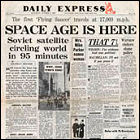 Under the direction of President Eisenhower, the U.S. Department of Defense establishes a high-tech think tank, the Advanced Research Projects Agency (ARPA), to conduct scientific and technological research with both national security implications and purely for technological advancement. The formation of ARPA is a direct response to the Soviet launch of the Sputnik satellite, and in the years ahead ARPA will lay the cornerstone of what will later become known as the Internet, as well as making significant strides in space science, though the space-related part of ARPA’s initial charter will later be transferred to a new agency called NASA. As the Cold War heats up, ARPA will be renamed DARPA (Defense Advanced Research Projects Agency) and its slate of R&D projects will become almost entirely military-oriented.
Under the direction of President Eisenhower, the U.S. Department of Defense establishes a high-tech think tank, the Advanced Research Projects Agency (ARPA), to conduct scientific and technological research with both national security implications and purely for technological advancement. The formation of ARPA is a direct response to the Soviet launch of the Sputnik satellite, and in the years ahead ARPA will lay the cornerstone of what will later become known as the Internet, as well as making significant strides in space science, though the space-related part of ARPA’s initial charter will later be transferred to a new agency called NASA. As the Cold War heats up, ARPA will be renamed DARPA (Defense Advanced Research Projects Agency) and its slate of R&D projects will become almost entirely military-oriented.
The first hard disk drive
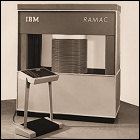 IBM announces the IBM 305 RAMAC (Random Access Memory Accounting) mainframe, a computer as large as two refrigerators, containing the new 350 Disk Storage Unit, the world’s first hard disk drive. The nearly-six-foot-high drive consists of a huge metal case surrounding a towering stack of 50 double-sided magnetic platters, adding up to a total capacity of four megabytes. In 1958, IBM will introduce the option to double capacity by adding a second stack of drive platters to the casing. The 305 RAMAC and 350 Disk Storage Unit together weigh over a ton, and are leased to IBM’s clients for $3,200 per month.
IBM announces the IBM 305 RAMAC (Random Access Memory Accounting) mainframe, a computer as large as two refrigerators, containing the new 350 Disk Storage Unit, the world’s first hard disk drive. The nearly-six-foot-high drive consists of a huge metal case surrounding a towering stack of 50 double-sided magnetic platters, adding up to a total capacity of four megabytes. In 1958, IBM will introduce the option to double capacity by adding a second stack of drive platters to the casing. The 305 RAMAC and 350 Disk Storage Unit together weigh over a ton, and are leased to IBM’s clients for $3,200 per month.